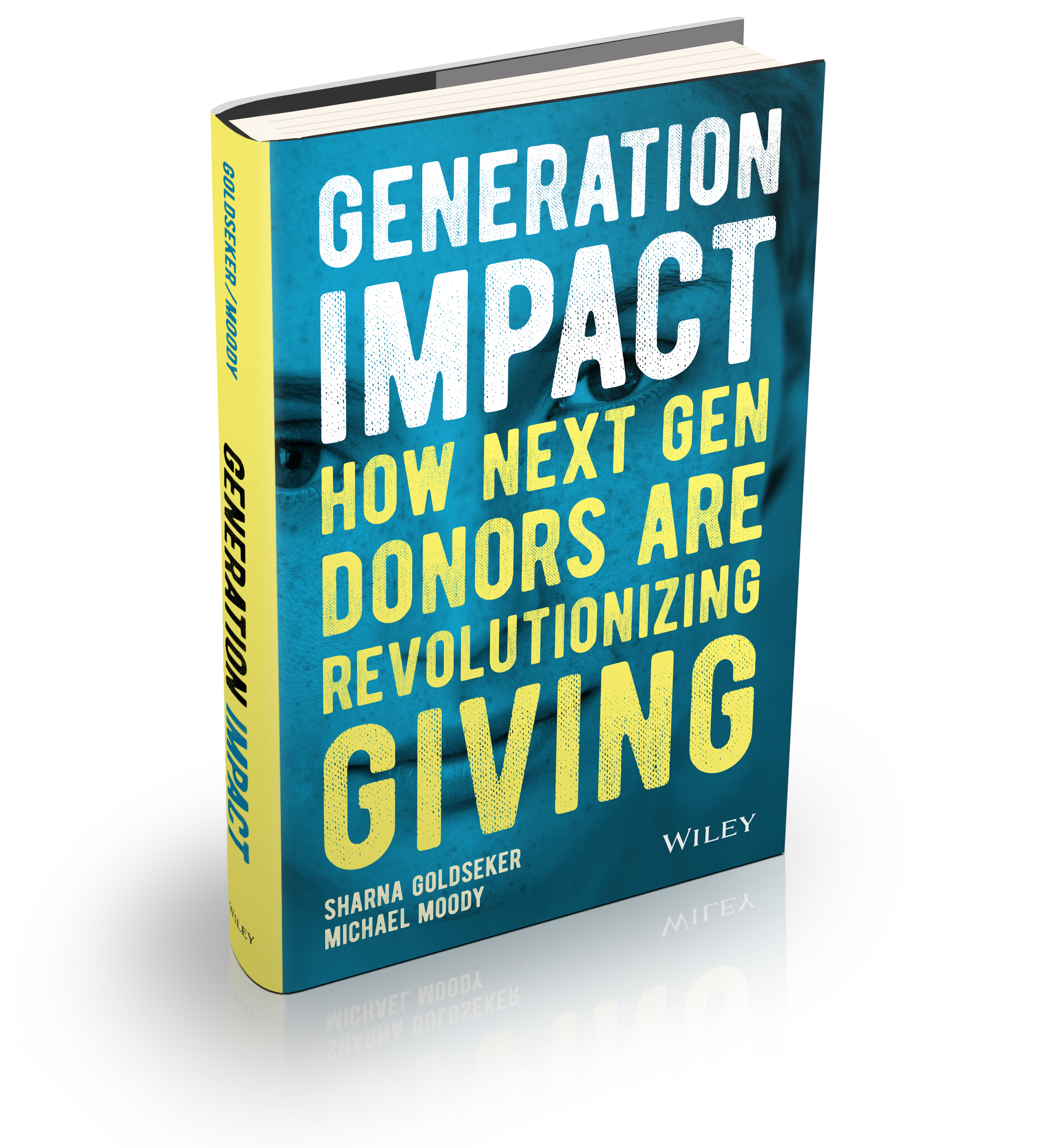Based on a national survey, 75 in-depth interviews and a combined two score years of work in the field, we published a book entitled Generation Impact: How Next Gen Donors Are Revolutionizing Giving.
The book is chock full of ways to engage Generation X and Millennial major donors – those destined to be the most significant donors in history.

Among the major findings of the book is how next gen donors don’t just want to write checks but want to “go all in” and give of their time, talent, and treasure to effect change. But we also add a fourth “T” to this standard list: the “ties” that next gen donors also see as a valuable asset, both for their own learning and as something they can contribute to organizations they care about. While previous generations have social connections too, next gen donors utilize their networks in more intensive ways – as a source of learning, inspiration, strategy, and leverage to expand their potential for impact.
Jenna Weinberg, Slingshot Board member, is featured prominent in the book, writing candidly about the benefits for her own donor journey of being deeply involved in peer networks like Slingshot. Below are some selections from Jenna’s first-hand account:
Philanthropy Is the Change I Want to Make in the World
So how did my thinking about philanthropy and my relationship to it evolve? After my junior year of college, I participated in a retreat called Grand Street, a program of 21/64, which provides a peer network and tools for Jewish next gen donors who are or will one day be involved in their family’s philanthropy. This retreat was life-changing. It empowered me to ask my parents the questions about this inherited legacy that I had never previously known how to ask.
Coming to terms with my inheritance, beyond the dollars, was an empowering process of self-exploration that was enhanced by doing so with my peers in Grand Street. Through Grand Street, I learned about Slingshot. The idea for Slingshot emerged over a decade ago at one of the first Grand Street retreats. Participants in that retreat felt disconnected from the organizations their parents supported and were looking for new ways to engage in Jewish philanthropy. The result was the creation of the Slingshot Resource Guide—a Zagat-style guide that highlights the most innovative and impactful Jewish organizations in North America.
Soon after, this group of young donors created a collaborative giving circle called the Slingshot Fund, which I joined after moving to New York when I graduated from college. The Slingshot Fund is comprised of Jewish funders in their twenties and thirties, who pool their contributions in order to leverage those dollars to make larger gifts. Only organizations featured in the guide are eligible for funding.
Participating in the Slingshot Fund gave me a network of peers who were interested in funding Jewish innovation, exposed me to dozens of Jewish organizations that were relevant to me, encouraged me to grapple with my Jewish and philanthropic values, and empowered me to advocate for the organizations I believe in. It helped me realize that check-writing isn’t what philanthropy means to me; rather, philanthropy is thinking about the change I want to make in the world and using everything I have to try to accomplish that change.
After participating in the Fund for two years and feeling the impact of this experience, it was only natural for me to join Slingshot’s board of directors when asked. Beyond the fact that Slingshot has allocated more than $3 million to small, underfunded, innovative organizations across the country, it has also created real, meaningful opportunities for the donors involved to contribute in other ways aligned with the organization’s mission. Being more hands-on and engaged in the organization’s governance, decision-making, and operational work has been critical for me.
Since I’ve always felt that philanthropy isn’t just about writing a check and patting myself on the back, this opportunity to serve Slingshot with my other resources felt right to me. When Slingshot’s founding executive director decided to leave the organization after five years for a new career opportunity, fellow board members asked if I’d step off the board temporarily in order to step in as the interim director. I was glad I could help the organization at such an integral moment in its growth. Now that I am back on the board with our new executive in place, I have even more to contribute, since I understand the organization in more intimate ways than perhaps any other board member. Supported by my peers on the board and using my professional background in working with nonprofits, I feel like I affected organizational change with my skills and networks, and not just by using my financial resources.
—Jenna Weinberg, Slingshot Board member
From Jenna and others like her we learned how critical peer networks are for helping next gen donors come to terms with their philanthropic identity, and how peer giving circles help their members learn, grow, leverage greater impact, and become more strategic as donors. Peer donor networks allow members to share expertise and experiences, and take advantage of the “collective genius” of the group to craft a more thorough and objective analysis of funding proposals, and then to make more effective philanthropic investments.
For more on Jenna’s story or to explore Generation Impact, visit GenerationImpactBook.org. To become involved with a Grand Street retreat and Slingshot giving cycle, email Adina Schwartz at adina@2164.net

